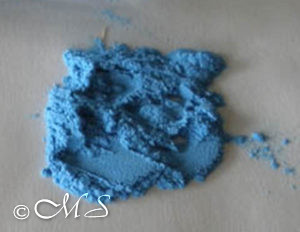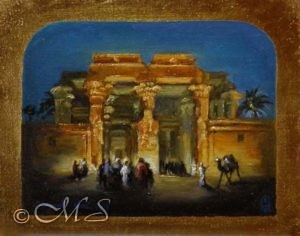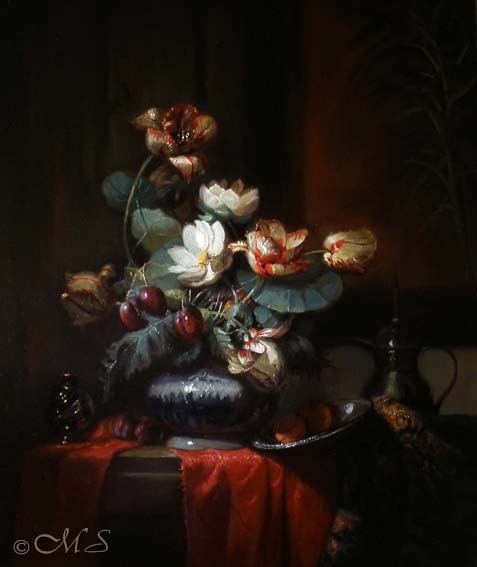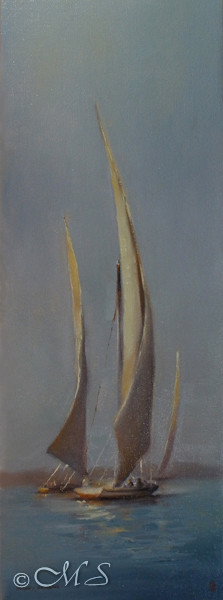Besides making paints, now there is a newly found use for the ancient pigment, Egyptian Blue Frit. This pigment, made by heating a mixture of copper, quartz, sand, lime, and an alkali, dates from 3250 BCE and was used to decorate tombs, statues, coffins, and temple walls in Egypt during the long reign of the Pharaohs.
Who Knew Pigments Could Be CSI Aids

from Natural Pigments
Modern day investigators and scientists have discovered a surprising new method of dusting the pigment onto complicated surfaces (shiny or highly patterned) to detect fingerprints left behind by careless criminals. This will aid law enforcement in the quest for solving crimes. In simple terms, existing fingerprint methods are enhanced by brushing the blue pigment on the complex surfaces, then photographing under a white light with a specific camera and filter. The near-infrared rays will glow which will reveal fingerprints.
Egyptian Blue Frit Invaluable in Lessons from the Pharaoh Series

8×10 Oil on 24 Carat Gold Leaf
Copyright Margret E. Short 2009
Private Collection
As you may recall, I used Egyptian Blue pigment extensively in my Lessons from the Pharaoh’s Tomb I and II project series in 2009/11. In my research, I found there was speculation the pigment was possibly developed by accident when, during a faience making project, the heat source failed to reach the necessary 2000 degree mark by half. This resulted in crumbling particles that, when cooled, could be crushed into a beautiful blue pigment.
Here in Kom Ombo, I used the pigment to portray the glowing night sky which contrasts perfectly against the golden walls of the temple. Below left, the pigment was useful when mixed with white for the subtle blue of the sky and the color of the Nile River in Full Sail. For Cleopatra’s Garden, I imagined a lush garden designed by Cleopatra herself, tended to by her many servants. Among the many things, she cultivated tulips, plums and other fruits, and what would an Egyptian garden be without the famous lotus. The blue was used subtly here in the flower vase. And now to be used in modern day law enforcement! Really amazing!

28×22 Oil on Linen
Copyright Margret E. Short 2009
Private Collection

22×8 Oil on Linen
Copyright Margret E. Short 2009
Private Collection

Aloha and Mele Kalikimaka to you and Dave,
Another fascinating post, which your thousands of fans have come to expect.
Hope you’re both doing well and enjoying the holidays. Michele and I wish you all the best in the New Year. Any plans to visit Hawaii this winter? We’ll keep a light–or should I say tiki torch on for you!
Hello Gary and Michele, So nice to hear from you, and to hear also that you enjoyed the post. Bet you guys are basking in sunshine while we lowly main-landers are snuggled in front of our radiators. Who knows, someday we just might look for that tiki. Happy Holidays to you both!
That’s interesting csi news.
Thanks Annie, this was really an interesting discovery with a direct connection to my painting. I just couldn’t resist writing about it. Happy Holidays!
Wonderful, Margret! I always find your posts full of beauty and inspiration, and as a sculptor, find the materials research so interesting.
Keep on keeping one, talented one!
Hello Cathy, Thank you so much for your nice comments. I’m sure, in your chosen medium of sculpture, you find lots of fascinating connections also. It is always fun to stumble upon a story about something, heretofore unknown, and relate it to our own art. It allows for an even deeper understanding of the world around us. Happy Holidays!
A science and history lesson with your beautiful art!
Hi Holly, I am so glad you enjoyed both the science and the history lesson. This was a total surprise to learn about the CSI connection to a natural pigment that I have used so often in my paintings. Who knew?